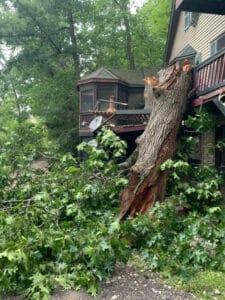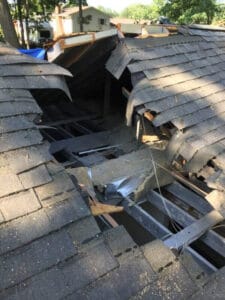
In this continuing series, the No. 6 most common damage to the home is caused by storms, trees and wind.
Deanna Robbins of Gateway Restoration said, “Our No. 6 category includes storms, trees and wind damage, which represents 8 percent of our claims.”
She said homeowner’s insurance helps cover damage caused by storms from water and ice damage, lightning strikes, power surges, wind/hail damage and fallen trees.
Robbins also said when it comes to tree damage, policies vary, but generally the following applies: You are typically covered if a tree or branch falls on your property due to a wind storm, lightning or other peril that’s included in your homeowners policy. But you’re not covered for damage that’s considered a maintenance issue, such as not pruning back branches, or damage caused by tree roots.”

Below are a couple of memorable claims Gateway Restoration has encountered in the past year:
The homeowner who had a tree come through his kitchen ceiling and pin him to the kitchen floor (he is okay).
The homeowner who left to go shopping with all of her windows open and high winds blew significant amounts of water through their house resulting in all of their laminate flooring having to be replaced – and it happened on two different occasions.
Robbins explained “It is always a good idea to take some time to prepare your house, so you can prevent storm damage. Your house is a major investment, and by taking a few simple steps you can protect it from storm damage.

Here are a few tips to help prevent storm damage:
- Clean your gutters
- Inspect and repair any cracks in foundation
- Check for dead or diseased trees
- Secure furniture inside the home and move furniture away from doors/windows
- Have your roof inspected yearly and fix any loose siding
- Check your landscaping and design landscaping to guide water away from your home
- Pack up your outdoor furniture
- Know where and how to shut off your utilities
- Unplug all your electronics
- Identify a safe room in your home
- Shutter your windows
- Build a disaster kit
- Keep an eye on the weather

Finally, Robbins offered these tips when filing a storm damage claim:
- Act quickly. Filing a claim with your insurance company for storm damage in a timely manner is important, because most insurance policies have time limits to file a claim. You’ll also want to repair the damage to your home or property before it has a chance to get worse, so reporting your claim early is always the best approach.
- Know your policy. You should be familiar with what is covered, how to proceed and what to expect from the process. Every insurance policy and claim is different. Reviewing your policy gives you information that specifically applies to you.
- Document everything. Keep a log of the storm and damage. For example, save news reports and take a lot of photos immediately after to document any damage.
- Call a restoration company as soon as possible to mitigate and start the process of cleaning up and repairing any damage. You might need a tarp, board up or other things to secure your property.
- Be wary of scammers! Unfortunately, storm damage can bring scammers to your area with promises of quick and cheap repairs. Whether you are filing a claim or not, look for contractors who are licensed, insurance and experienced.
- Sign up for SMS/text alerts. Many insurance companies use SMS/text message alerts that will notify you of the status of your claim. You will receive text messages on your phone when you first report your claim, when your estimate is available, and when a payment has been sent.
“Be sure to join us next week for our No. 5 of the Top 10 Countdown Most Common Damages to the Home – it is a big one and loaded with great information,” she said.



















